Despite COVID-19 bringing a year of immense disruption, technology like digital workplace software has meant many office-based businesses were able to survive. But as 2020 begins to wrap up, and a vaccine could be on the horizon, business leaders may be reconsidering their remote working policies.
To make this decision, it’s important to look at 2020 as a case study and ask: Is remote working effective? Are employees more productive under the watchful eye of managers?

To explore this topic, Capterra surveyed 1,400 Australian employees (from junior staff through to leadership teams and business owners) to ask how they would rate their productivity throughout the year.
Respondents were from a mixture of remote and non-remote-settings to allow us to explore differences in answers—a full methodology is available at the bottom of this article. Read on to discover the five most important statistics for businesses to consider when building their flexible remote working policies for 2021.
5 remote working statistics from 2020
-
Around two-thirds of Australian employees are working remotely
As of November (2021), 64% of employees working for a small or medium-sized business in Australia are working remotely full-time or part-time. This statistic is up from 57% since March 2020 (when the country originally went into a lockdown and Capterra first surveyed Australian employees about remote working circumstances).
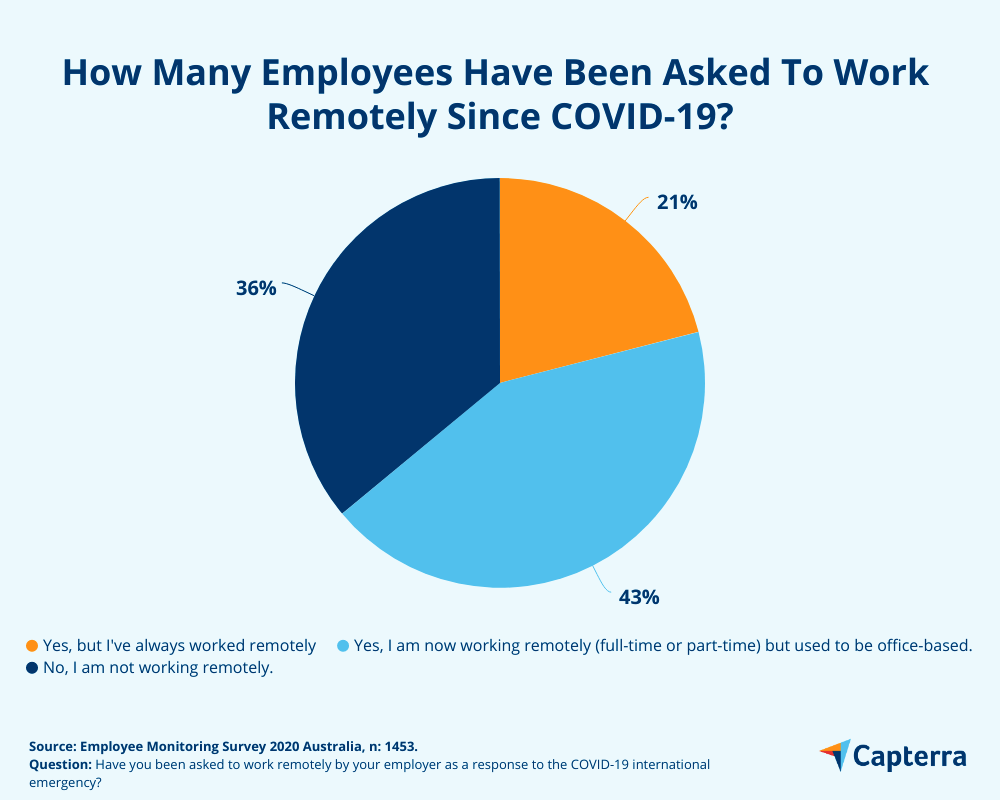
While 21% of respondents said they have always been a remote worker, 43% were new to the concept this year.
How to apply this into a flexible work policy?
This year has proven that working with a distributed workforce is possible. As a result, it makes sense that many companies will be looking to relax their viewpoints toward remote working.
From a talent attraction and retainment perspective, a flexible work policy provides companies with a competitive edge. Capterra’s remote working survey found that 87% of employees would like to continue working remotely after the lockdown ends.
2. 78% of staff say they’re just as (or more) productive at home
At the beginning of the lockdown, employers were understandably nervous about transitioning to a remote working environment. Their biggest concerns and immediate priorities at the time included retaining staff and ensuring they could remain productive while working from home.
Fortunately, the majority of staff said they’ve been able to work well in a home-office environment. Just 4% of employees surveyed said they’re less productive since working from home, and only 1% said they’re struggling.
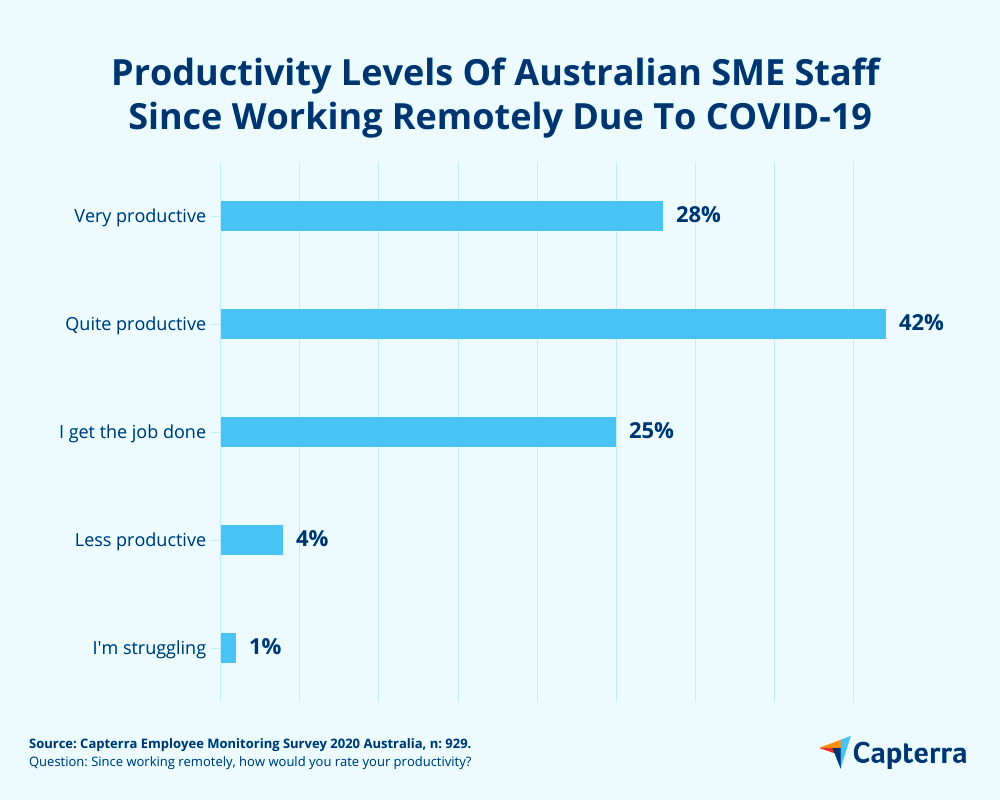
Taking aside the disruptions and distractions of the pandemic, Capterra was keen to understand which environment sets employees up for greater productivity. 38% of employees surveyed said they’re just as productive at home while 44% said they’re more productive at home. Combined, these figures indicate that working outside of the office has its benefits.
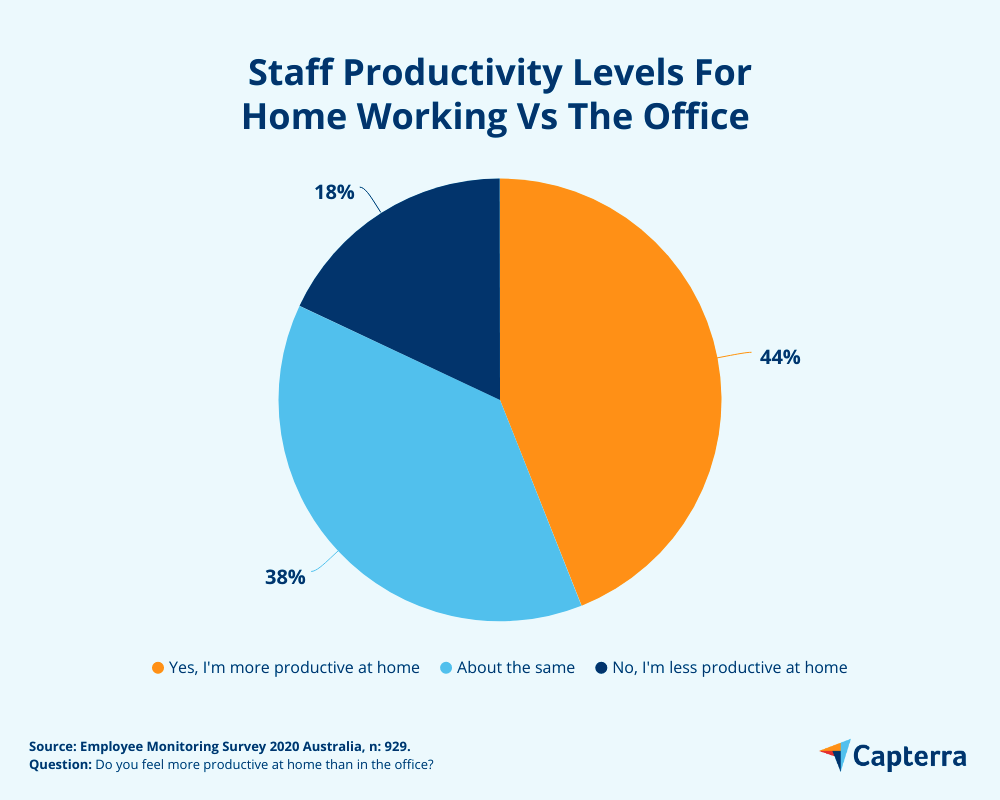
How to apply this to a flexible work policy
With the correct resources in place, staff can be productive in a digital environment—as proven this year. However, it’s important to note that around one in five staff members (18%) said they are less productive at home. The office may not be as critical to a business’s productivity levels as it was viewed at the start of this year, but it still has a place.
Instead of a one-size-fits-all approach to remote working, consider a more flexible arrangement that allows staff to flourish in all environments, at any given time. For example, by offering flexible working hours or allowing employees to work from home for a certain amount of days per week.
3. 31% of remote staff say they feel they could be less managed
Capterra asked remote and non-remote staff to put themselves on a scale with regards to how well they feel they’re managed. There was only a small minority of respondents feeling extremely unsupported or extremely micromanaged. The rest (88%) sat somewhere in the middle.
However, there were some key differences between the answers of remote vs non-remote respondents.
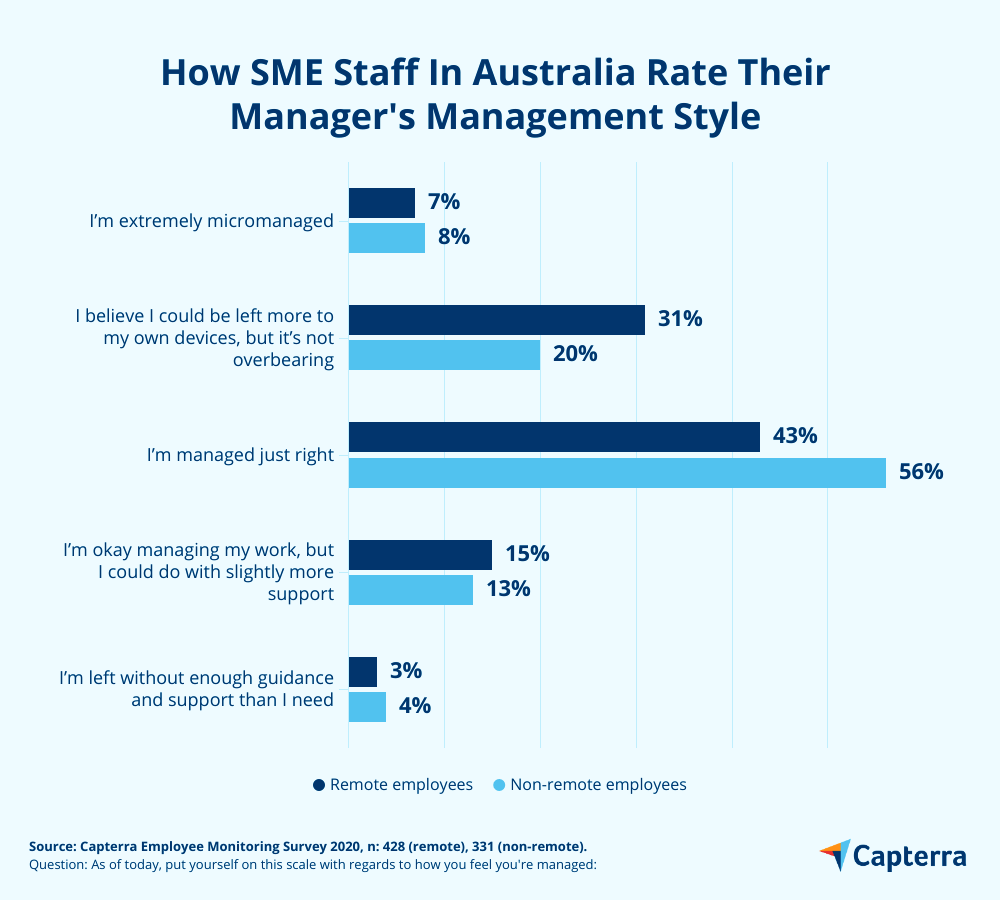
More than half (56%) of employees who are working in the office say they’re managed just right. This is slightly less for remote employees at 43%.
Remote employees are also more likely to feel their manager could loosen the reins. Around a third (31%) of them said they believe they could be ‘left more to their own devices,’ compared to just 20% of non-remote employees.
How to apply this to your remote work policy
As a manager, it’s your duty to ensure your team can work at peak productivity, but in a remote setting, it can be tricky to provide the right amount of support without interfering.
Unfortunately, there isn’t a one, set formula for getting this right—primarily because every employee is different. However, if managers are worried about staff slipping into bad habits when out of the office, set some ground rules. Here are five examples:
- Get dressed before starting work
- Work from a desk or table (where possible)
- Remove distractions (where possible)
- Respond to messages within an hour
- Let your team know when you’re going on breaks.
Remote working policies provide an ideal opportunity for companies to establish how they expect staff to operate while working from home. By including these ground-rules, it instantly puts everyone on the same page.
4. 27% of remote staff feel very comfortable taking entitled breaks
Just over a quarter (27%) of remote staff said they’re very comfortable to take their entitled breaks; compared to more than a third (35%) of non-remote staff.
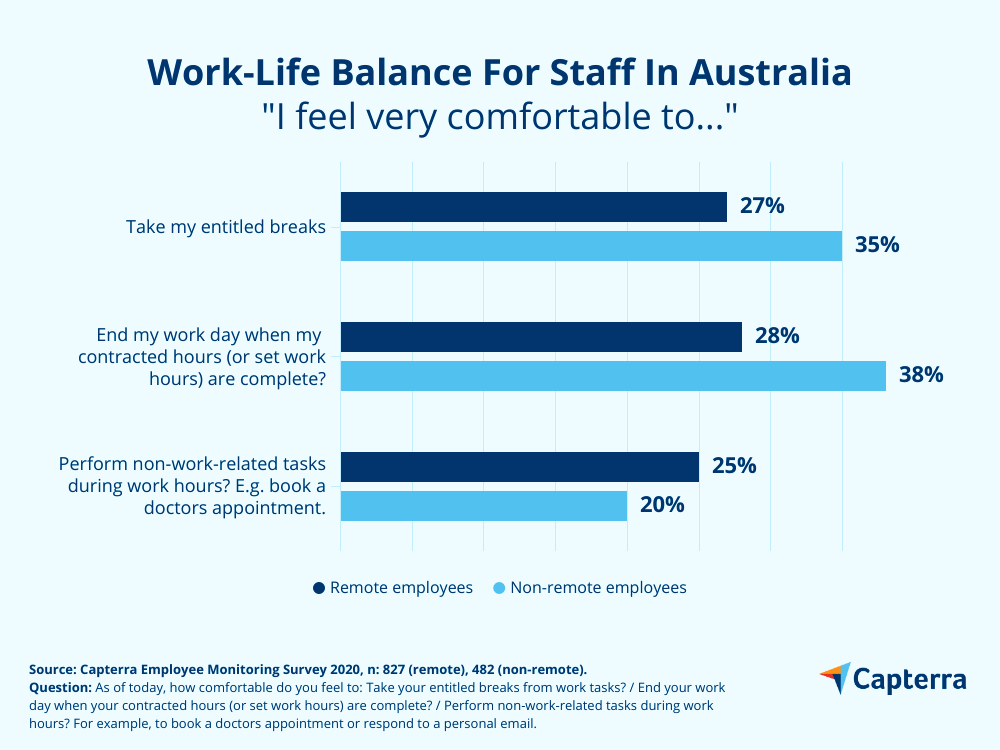
Additionally, there is a 10% decrease in remote staff feeling very comfortable to finish work at the end of their workday. This suggests that remote workers haven’t settled into a healthy work-life balance yet.
How to apply this to your remote work policy
Employers must keep an eye on how many hours their staff members are working to prevent issues, such as burnout. One way to monitor this is through time-tracking software. However, businesses should use their remote working policy to explain the reasons why they’ve chosen to use monitoring tools. Not doing so can negatively impact trust and lead to employees feeling policed rather than supported.
5. Use of employee monitoring tools increased by 15% during COVID-19
Since COVID-19 restrictions came in, 15% more business leaders within small and mid-sized businesses are using employee monitoring software. However, 44% said they were already using it.
Capterra asked business leaders and employees to give their stance on whether they believed employee monitoring software is generally positive or negative for businesses: 73% said it was positive. However, this number changes depending on whether the respondent is operating in the office or at home.
78% of remote leaders think employee monitoring tools are positive, compared to 51% of non-remote leaders.
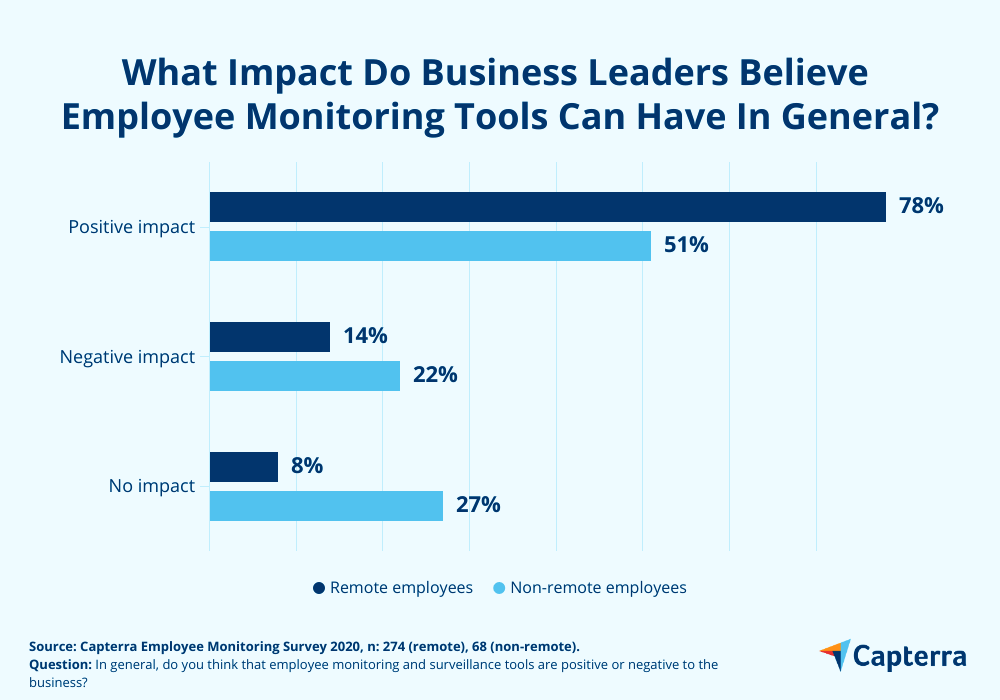
Those in the office are also more likely to say the software has no impact on the business. This indicates that business leaders see less of a need for the software when operating in an office structure.
The employee perspective
In general, employees are significantly less enthusiastic about tracking tools in comparison to their leaders. However, similar to above, remote employees tended to see more value in employee monitoring tools than those who are office-based.
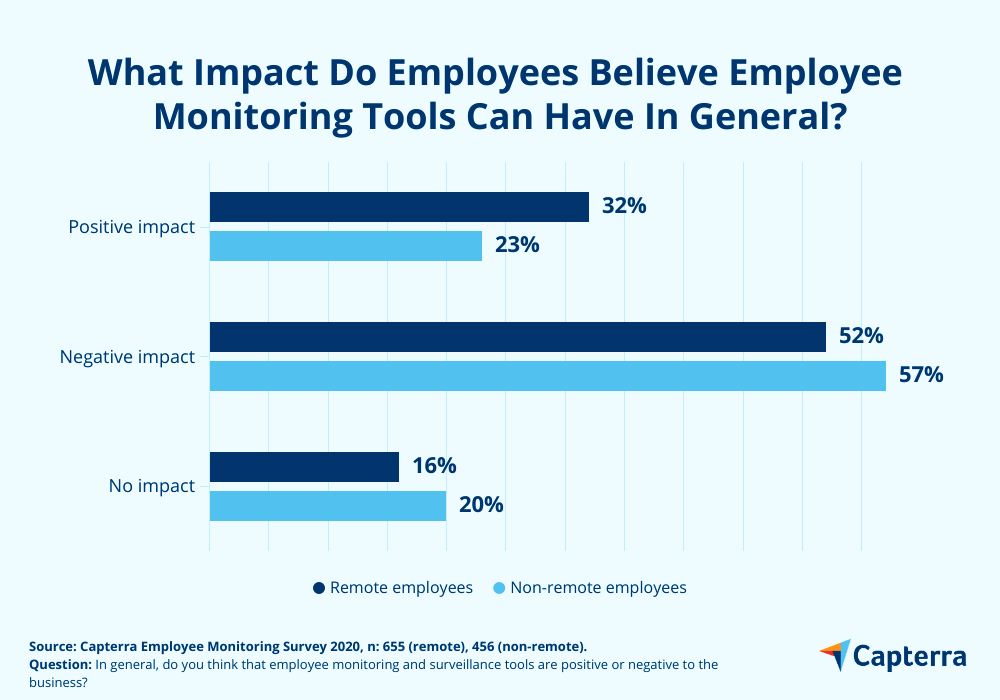
How to apply this to your remote work policy
The majority of employees said they feel employee monitoring could negatively impact the business—while the remaining few didn’t believe it would have any impact at all. With this in mind, business leaders should work to win the buy-in of employees to justify the use of tracking software. Otherwise, they risk amplifying anxiety and concerns.
Find the right balance when creating remote work policies
A large amount of successful remote working arrangements is founded on trust. However, establishing a remote working policy puts everyone on the same page—which should save you some headaches later on from discovering people have a different perception of what ‘flexible’ means.
If this your first flexible remote working policy, you may want to consider involving your staff in the conversation. Start by defining the type of arrangement that will enable your employees to thrive. For example, what tools do they need to be successful? With their perspective, you’re more likely to create a policy that keeps employees happy.
Remote Working Statistics: Survey methodology:
Capterra ran a survey to highlight the most important remote work statistics from 2020, to allow companies to make better-informed decisions around remote working policies.
The survey ran during October 2020 and had 1,400 respondents take part. To qualify for this survey, respondents had to be employees of an Australian small or medium-sized business.





